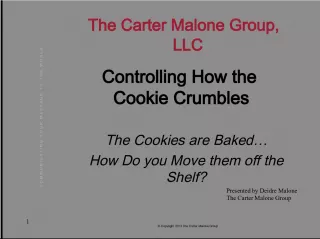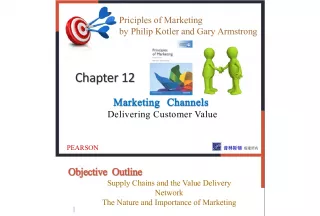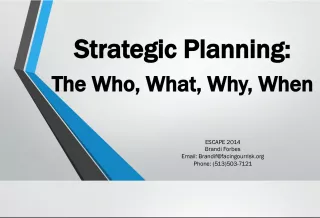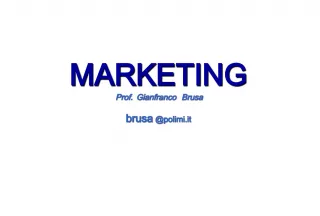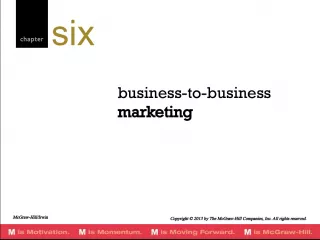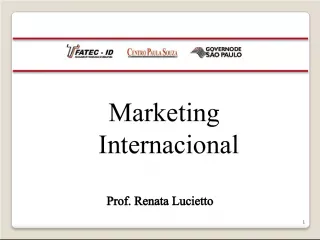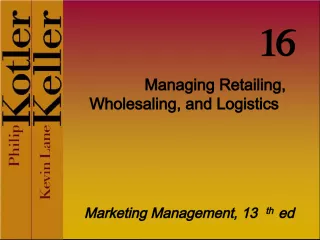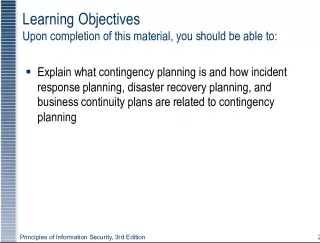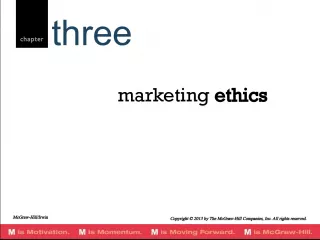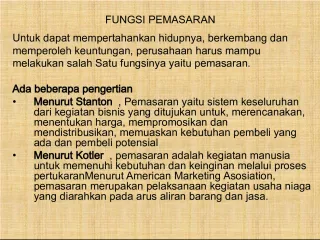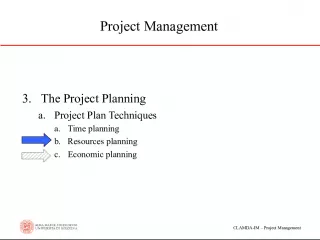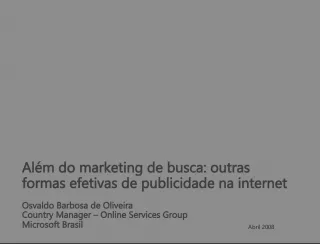Understanding the Basics of Brand Planning and Integrated Marketing


This article discusses the fundamental concepts of brand planning and integrated marketing communications (IMC), including brand birth, equity, and IMC strategic planning. It also explores the relationship between the advertising spiral and the product life cycle.
- Uploaded on | 0 Views
-
 katrina
katrina
About Understanding the Basics of Brand Planning and Integrated Marketing
PowerPoint presentation about 'Understanding the Basics of Brand Planning and Integrated Marketing'. This presentation describes the topic on This article discusses the fundamental concepts of brand planning and integrated marketing communications (IMC), including brand birth, equity, and IMC strategic planning. It also explores the relationship between the advertising spiral and the product life cycle.. The key topics included in this slideshow are Dr H Ronald Moser, Cumberland University, Kleppners Advertising Procedure, brand planning, integrated marketing communications, IMC strategic planning, product life cycle, advertising spiral, Lane, King, Reichart,. Download this presentation absolutely free.
Presentation Transcript
1. Dr. H. Ronald Moser Cumberland University Kleppners Advertising Procedure
2. Chapter 3 Brand Planning and the Advertising Spiral Kleppners Advertising Procedure, 18e Lane * King * Reichart
3. Learning Objectives Discuss the birth and basics of branding. Explain brands and integrated marketing. Discuss brand equity. Explain IMC (Integrated Marketing Communications) strategic planning. Explain the importance of the product life cycle. Discuss the relationship of the advertising spiral.
4. Building Strong Brands and Equity Brand A brand is a name, term, sign, design, or a unifying combination, intended to identify and distinguish the product or service from competing products or services. Advertisers and their agencies are likely to agree that a brand is an organizations most valuable asset. A product is manufactured while a brand is created. The building blocks that generate a brands value are trust, image, and familiarity.
5. Exhibit 3.1 Zippo: A leading brand since the 1930s Building Strong Brands and Equity EXHIBIT 3.1. Zippo has been a leading brand since the 1930s. This trade ad tries to convince retailers to carry the product because it is a leading brand.
6. Building Strong Brands and Equity Brand The Origin of Branding The way that early manufacturers used to differentiate their products from their competitors was the best deal to wholesalers so their products were distributed. Brand Connections Above all else, branding has been historically, and still is today, all about making connections selling a product. Branding Channels and Engagement Branding today is not about the media: its about ideas.
7. Building Strong Brands and Equity Brand The Origin of Branding The way that early manufacturers used to differentiate their products from their competitors was the best deal to wholesalers so their products were distributed . Branding As A Financial Decision Branding isnt an advertising decision. Its a financial decision. We have learned that creating brand leverage is about dealing correctly with strategic issues and financial commitments at the top management levelthen taking the risks necessary to deliver category-dominating creations.
8. Building Strong Brands and Equity Brand The Origin of Branding The way that early manufacturers used to differentiate their products from their competitors was the best deal to wholesalers so their products were distributed. Digital Influence A major change in the brand environment today stems from the influence of digital communications. Digital communication allows the world to determine whether a brand is practicing what it preaches. In todays digital world, the brand and the brand organization must perform, behave, and satisfy the consumers needs as they expect.
9. Brands and Integrated Marketing Communications Integrated Marketing Communication - The name given to the process of coordinating messages throughout a number of touch points, building brand equity, and building better marketing strategies for a product is Integrated. Marketing Communication - Increasing use of cash incentives, coupons, and premiums is beginning to replace traditional models of advertising and consumer communication.
10. Brands and Integrated Marketing Communications Brand Equity Brand Equity Is the value consumers, distributors, and salespeople think and feel about a brand relative to its competition over a period of time. Many powerful brands today were among the earliest brands: Budweiser, Ivory, Coca-Cola, Campbells Soup, Hersheys Chocolate, Maxwell House Coffee, and Levis. Brand equity can be increased by using integrated marketing communications.
11. Brands and Integrated Marketing Young & Rubicams Brand Asset Valuator One of the most respected proprietary tools in the industry for assessing a brands stature among consumers is the Brand Asset Valuator (BAV) created by Young & Rubicam (Y&R). It is a diagnostic tool for determining how a brand is performing relative to all other brands. The Brand Asset Valuator created by Young & Rubicam evaluates weaknesses and strengths of a brand according to vitality and stature.
12. Brands and Integrated Marketing Young & Rubicams Brand Asset Valuator Claim: Brands are built over the progression of four primary consumer perceptions : Differentiation -The basis for choice: the essence of the brand, source of margin. Esteem - Deals with consumer respect, regard, and reputation consumers expect. Relevance - Relates to usage of the five Ps of marketing related to sales. Knowledge - The culmination of brand- building and relation to consumer experience.
13. Brands and Integrated Marketing Y&Rs Brand Value Structure Brand Value Brand Vitality Differentiation Relevance Brand Stature Esteem Knowledge Young & Rubicam view a brands stature as a combination of familiarity and esteem that is, whether people know and understand your brand and whether they like it . A brands vitality lies in a combination of differentiation and relevance. A brand must be distinct, or it simply isnt a brand. Unless a brand is also relevant, the consumer has no reason to select it.
14. Brands and Integrated Marketing Developing IMC Strategic Plans Brand Equity Audit Analysis Strategic Options Brand Equity Research Creative Brief Before you start to think about creating advertisements for brand, you need a strategic plan. Before you can develop a strategic plan, your need and understanding of the marketing situation and a clear understanding of the brands equity. There are four logical steps in this process resulting in the creative brief or plan :
15. Brands and Integrated Marketing Developing IMC Strategic Plans 1. Brand Equity Audit Analysis Strategic Options Brand Equity Research Creative Brief Before you start to think about creating advertisements for brand, you need a strategic plan. Before you can develop a strategic plan, your need and understanding of the marketing situation and a clear understanding of the brands equity. There are four logical steps in this process resulting in the creative brief or plan :
16. Brands and Integrated Marketing Areas Examined in a Brand Equity Audit Analysis Market Context . Brand Equity Strengths and Weaknesses. Brand Equity Descriptions. Competitive Strategies and Tactics . A Brand Equity Audit Analysis determines all of the following : There are a number of areas to examine in the first step, brand equity audit analysis. For instance, the context of the market, strengths and weaknesses, consumer attitude descriptions, and competitive strategies and tactics are of importance here.
17. Brands and Integrated Marketing Areas Examined in a Brand Equity Audit Analysis Market Context Here we are looking for clues and factors that positively or negatively affect brand equity. The whole purpose is to set the scene. We must look at the market from varying angles and select only the relevant ones so that we can set the scene for understanding and building brand equity. A Brand Equity Audit Analysis determines all of the following:
18. Brands and Integrated Marketing Areas Examined in a Brand Equity Audit Analysis Brand Equity Strengths and Weaknesses Strength of brands equity: Market Share. Brand Sensitivity. Image Attributes. Brand Loyalty. A Brand Equity Audit Analysis determines all of the following:
19. Brands and Integrated Marketing Areas Examined in a Brand Equity Audit Analysis Brand Equity Descriptions Here we need to review all the available research to get as close a feeling as possible on how consumers view the brand and how they feel about it. Second, we must analyze in depth our brands and its competitors communications over a period of time. It is from these communications that most of consumers feelings (emotional elements) and opinions (rational elements) about the brand are derived (see Exhibit 3.3). A Brand Equity Audit Analysis determines all of the following:
20. Exhibit 3.3. Basic Elements of a Brand Brands and Integrated Marketing EXHIBIT 3.3. Three Basic Elements of a Brand.
21. Brands and Integrated Marketing Brand Equity Description: Golf GTI Emotional Elements Small Sports Car. Sets Me Free. Makes Me Look Good. Simple. There When I Want It. Im In Control. Rational Elements Inexpensive. High Gas Mileage. Retains Value. Durable. Dependable. Handles Well. A Brand Equity Description for the Golf GTI automobile might be as follows:
22. Brands and Integrated Marketing Areas Examined in a Brand Equity Audit Analysis Competitive Strategies and Tactics This area of the audit is designed to provide a clear summary of the current communication strategies and tactics of our brand and of key competitors. It should include an analysis of all integrated communications in relation to brand equity. Is the strategy designed to reinforce current brand equity? Who is the target audience? Are there different target audiences? What are the themes and executional approaches? How are the marketing funds being spent? A Brand Equity Audit Analysis determines all of the following:
23. Brands and Integrated Marketing Developing IMC Strategic Plans Brand Equity Audit Analysis 2. Strategic Options Brand Equity Research Creative Brief Before you start to think about creating advertisements for brand, you need a strategic plan. Before you can develop a strategic plan, your need and understanding of the marketing situation and a clear understanding of the brands equity. There are four logical steps in this process resulting in the creative brief or plan :
24. Brands and Integrated Marketing Strategic Options/ Recommendations Communication Objectives. Audience. Source of Business. Brand Positioning and Benefits. Marketing Mix. Rationale. The second step draws on the conclusions from the analysis to develop a viable recommendation plan. The Strategic Options include the following:
25. Brands and Integrated Marketing Strategic Options/ Recommendations Communication Object ives Here we are asking the question what is the primary goal the message aims to achieve? Audience To whom are we speaking? Source of Business Where are the customers going to come from for our brands or product categories? The second step draws on the conclusions from the analysis to develop a viable recommendation plan. The Strategic Options include the following:
26. Brands and Integrated Marketing Strategic Options/ Recommendations Brand Positioning and Benefits How are we to position the brand, and what are the benefits that will build brand equity? Marketing Mix What is the recommended mix of advertising, public relations, promotion, direct response, and etc.? The second step draws on the conclusions from the analysis to develop a viable recommendation plan. The Strategic Options include the following:
27. Brands and Integrated Marketing Strategic Options/ Recommendations Rationale How does the recommended strategy relate to and what effect is it expected to have on brand equity? The second step draws on the conclusions from the analysis to develop a viable recommendation plan. The Strategic Options include the following:
28. Brands and Integrated Marketing Developing IMC Strategic Plans Brand Equity Audit Analysis Strategic Options 3. Brand Equity Research Creative Brief Before you start to think about creating advertisements for brand, you need a strategic plan. Before you can develop a strategic plan, your need and understanding of the marketing situation and a clear understanding of the brands equity. There are four logical steps in this process resulting in the creative brief or plan :
29. Brands and Integrated Marketing Brand Equity Research In the third step, we do the Proprietary, Qualitative Research. It is exploratory and task-oriented research. Here, we need to determine which elements or elements of brand equity must be created, altered, or reinforced to achieve our recommended strategy and how far we can stretch each of these components without affecting the brands credibility.
30. Brands and Integrated Marketing Developing IMC Strategic Plans Brand Equity Audit Analysis Strategic Options Brand Equity Research 4. Creative Brief Before you start to think about creating advertisements for brand, you need a strategic plan. Before you can develop a strategic plan, your need and understanding of the marketing situation and a clear understanding of the brands equity. There are four logical steps in this process resulting in the creative brief or plan :
31. Brands and Integrated Marketing Creative Brief A Creative Brief (strategy or work plan) is a short statement that clearly defines the audience, how consumers think or feel and behave, what the communication should achieve, and the promise that will create a bond between the consumer and the brand. The final step is written Creative Brief (or work plan) for all communication. We synthesize all the information and understand into an action plan for the development of all communications for the brand: advertising, public relations, promotion, and etc.
32. Brands and Integrated Marketing Key Components of a Creative Strategy A Typical Creative Brief Strategy Would Include the Following: Key Observation The most important market/ consumer factor that dictates the strategy. Communication Objective The primary goal the advertising aims to achieve. Consumer Insight The consumers hot button our communication will trigger. Promise What the brand should represent in the consumers mind. Support The reason the promise it true. Audience To whom we are speaking and how do they feel about the brand. Mandatories Items used as compulsory constraints.
33. Exhibit 3.4. AFG Planning Cycle Brands and Integrated Marketing It is important to understand that there isnt only one approach to developing an integrated strategic plan for a brand. Lets take a look at the basics of a couple of other strategic planning approaches. In the seven-step planning cycle used to create strategic advertising designed by Avrett, Free, and Ginsberg, the advertising discipline that is employed is account planning .
34. Exhibit 3.4. AFG Planning Cycle Brands and Integrated Marketing Avertt, Free & Ginsbergs Planning Cycle: Brand Valuation AFG tracks marketplace performance and progress. Brand/Market Status - AFG evaluates where the brand is in its marketplace. Brand Mission After determining brand status, AFG proposes and agrees on brand goals. Strategy A used in developing a fully integrated communication program. Creative Exploration AFG develops, explores, and evaluates a range of executions. Brand Vision AFG plots long-range expansion plans for the base brand. Strategic Development Which options to consider. AFG uses a process called need mapping.
35. Exhibit 3.5. Example of AFGs Need-Mapping Process Brands and Integrated Marketing EXHIBIT 3.5. - An Example of AFGs Need-Mapping Process:
36. Brands and Integrated Marketing Typical Steps in the Planning Process Following are some of the typical steps agencies and clients take in the planning process. Evaluate Current Brand Status Here we are evaluating the brands overall appeal. Develop Brand Insights Here we may attempt to capture the words that best describe the brand. Identify Brand Vision Here we looking for the connection between the brand and the consumer. Express A Big Idea We are trying to determine when the consumer will be most receptive to the message. Evaluate Whether Objectives Are Met An essential aspect of communications is accountability.
37. Brands and Integrated Marketing What Great Brands Do A Great Brand: Is In It For The Long Haul. Can Be Anything. Knows Itself. Invents Or Reinvents An Entire Category. Taps Into Emotions. Is A Story That Is Never Completely Told . Is Relevant. Here we look at some of Scott Bedburys, former senior vice president of marketing at Starbucks Coffee, brand building principles:
38. Brands and Integrated Marketing What Great Brands Do A Great Brand : Is In It For The Long Haul A great brand is a necessity, not a luxury. Can Be Anything Some categories lend themselves to branding better than others, but anything is brandable. Knows Itself To keep a brand vital, you have to do something new, something unexpected. Here we look at some of Scott Bedburys, former senior vice president of marketing as Starbucks Coffee, brand building principles:
39. Brands and Integrated Marketing What Great Brands Do A Great Brand : Invents Or Reinvents An Entire Category - The common ground that you find among brands with some companies is that these companies made it an explicit goal to be responsible for each of their entire categories. Taps Into Emotions Emotions drive most, it not all, to make most decisions. Here we look at some of Scott Bedburys, former senior vice president of marketing as Starbucks Coffee, brand building principles:
40. Brands and Integrated Marketing What Great Brands Do A Great Brand : Is A Story That Is Never Completely Told A brand is a story that is evolving all the time. Here are saying the world is just a stage. Is Relevant A lot of brands are trying to position themselves as cool, but most of them fail. Here we look at some of Scott Bedburys, former senior vice president of marketing at Starbucks Coffee, brand building principles:
41. Exhibit 3.6. Primary Stages of the Life-Cycle Model The Advertising Stages of a Product Great importance is placed on the development of a product and its marketing objectives as part of a brands strategic plan prior to creating advertisements. Here we examine several aspects of product development and the advertising implications that are important to creating the strategic plan. The stages in the life-cycle model as it relates to advertising include: pioneering , competitive , and retentive .
42. The Pioneering Stage Purpose of the Pioneering Stage To Educate Consumers About New Products. To Show People They Have a Need That Advertised Product Can Fulfill. To Show That A Product Now Exists That Is Capable Of Meeting A Need That Had Been Recognized But Previously Unfulfilled . In 2008, 48,000 products filled a typical supermarket, up more than 50 percent from 1996. The purposes of the Pioneering Stage of a products life cycle is:
43. The Pioneering Stage Egg Beaters: Egg Alternative EXHIBIT 3.8. Egg Beaters Expands the market by trying to get the consumer to substitute Egg Beaters for eggs in Cooking.
44. The Pioneering Stage Purell Built a Need for Hand Sanitizer
45. Competitive Stage Purpose of the Competitive Stage The Competitive Stage is the advertising stage a product reaches when its general usefulness is recognized but its superiority over similar brands has to be established in order to gain preference. In the Competitive Stage , a pioneer of a newly accepted product usually has established an advantage of leadership that can give dominance in the market. The general acceptance by the consumer of a new product indicates that the product is entering into the Competitive Stage . Competitive Stage advertising is designed to answer the consumers question of which brand shall I buy?
46. Retentive Stage Purpose of the Retentive Stage The Retentive Stage is the third advertising stage of a product reached when its general usefulness is widely known, its individual qualities are thoroughly appreciated, and it is satisfied to retain its patronage merely on the strength of its past reputation. Advertising in the Retentive Stage includes poster-like dominant illustration of the product. Products are at their most profitable level in the Retentive Stage because development costs have been amortized. An advertisers main goal in the Retentive Stage is to maintain market share.
47. Brands in the Retentive Stage Purpose of the Retentive Stage McDonalds. Nike. Jell-O. Pepsi-Cola. Mountain Dew. Budweiser. Disney. ESPN. Google. Gillette. Brands that are Considered to be in the Retentive Stage.
48. Exhibit 3.11. The Advertising Spiral EXHIBIT 3.11. The Advertising Spiral is an expanded version of the advertising stages of products just discussed.
49. The Advertising Spiral Some Generalization To determine when a product reaches a particular stage(s) in a given market at a given time, and what the thrust of the advertising message should be, you can utilize the Advertising Spiral . Before you attempt to create new advertising for a product, you should use Advertising Spiral to answer the question in which stage is the product in. We have to remember that products in the Retentive Stage receive the least amount of advertising. The Advertising Spiral but not the life cycle model ignores the fact that a product nearing the end of the life cycle must decline. If a manufacturer determines that a product has outlived its effective market, the product lifecycle model would suggest to stop advertising and other types of promotional support. A strategy that a manufacturer might chose when a product has nearly reached the end of the Retentive Stage could be to expand the market into a Newer Pioneering S tage .
50. Exhibit 3.14. Expanded Advertising Spiral The New Pioneering Stage and Beyond EXHIBIT 3.14. A product entering the New Pioneering Stage is actually in different stages in different markets.
51. The New Pioneering Stage and Beyond Some Generalization A product entering the New Pioneering Stage in reality is in different stages in different markets. In the Newer Pioneering Stage , techniques used to entice more people to use the product include making product innovations. The advertising focus in the Newer Pioneering Stage is to have the consumer understand what the product is all about. The continuing discovery of new uses for aspirin has kept this product in the New Pioneering Stage.
52. Exhibit 3.15. Egg Beaters Expansion The New Pioneering Stage and Beyond Exhibit 3.15. The Newest Pioneering Stage focuses on getting more people to use the product .
53. WHAT ABOUT THOSE REVIEW QUESTIONS? THEY WILL BE THERE! S DRIVE The End!
